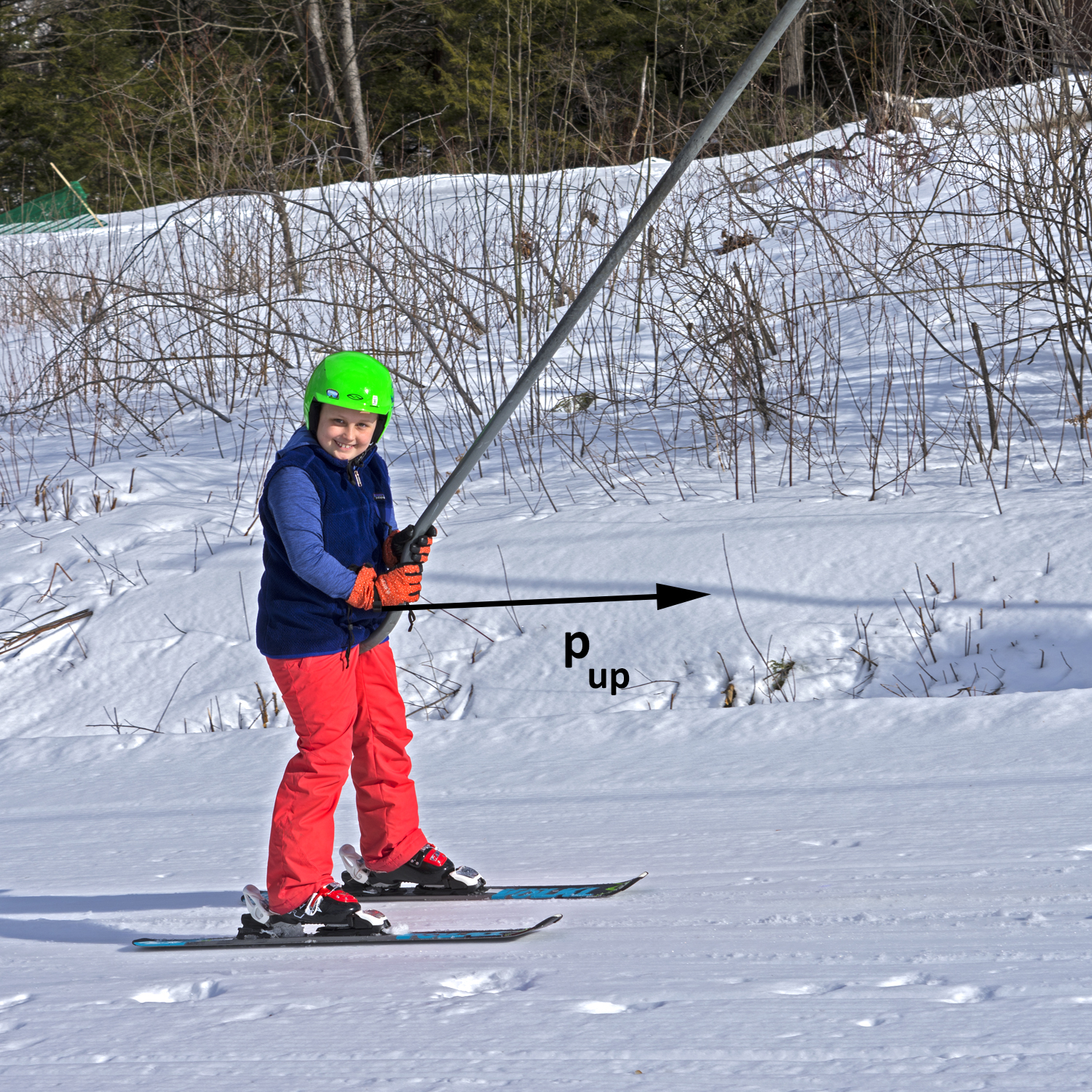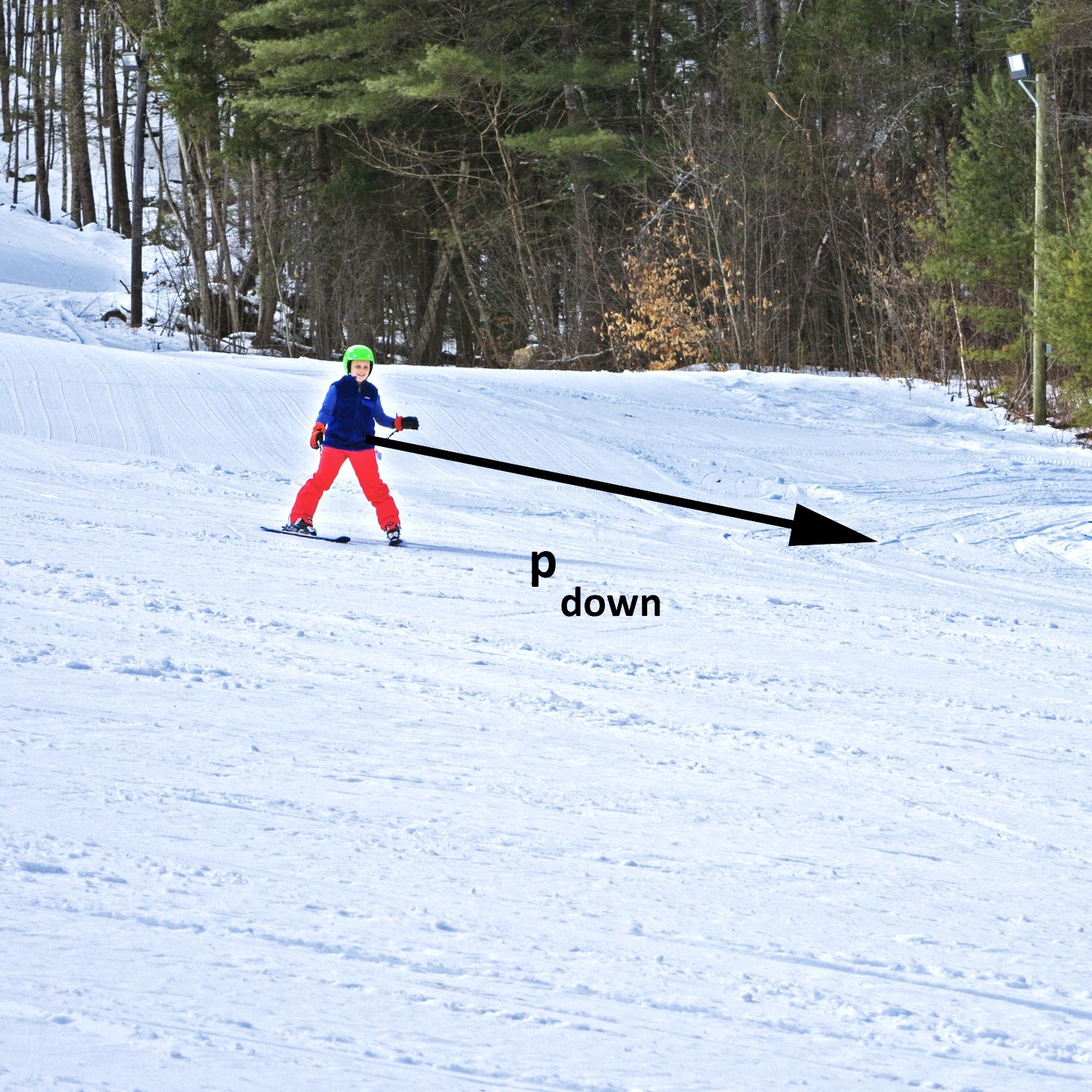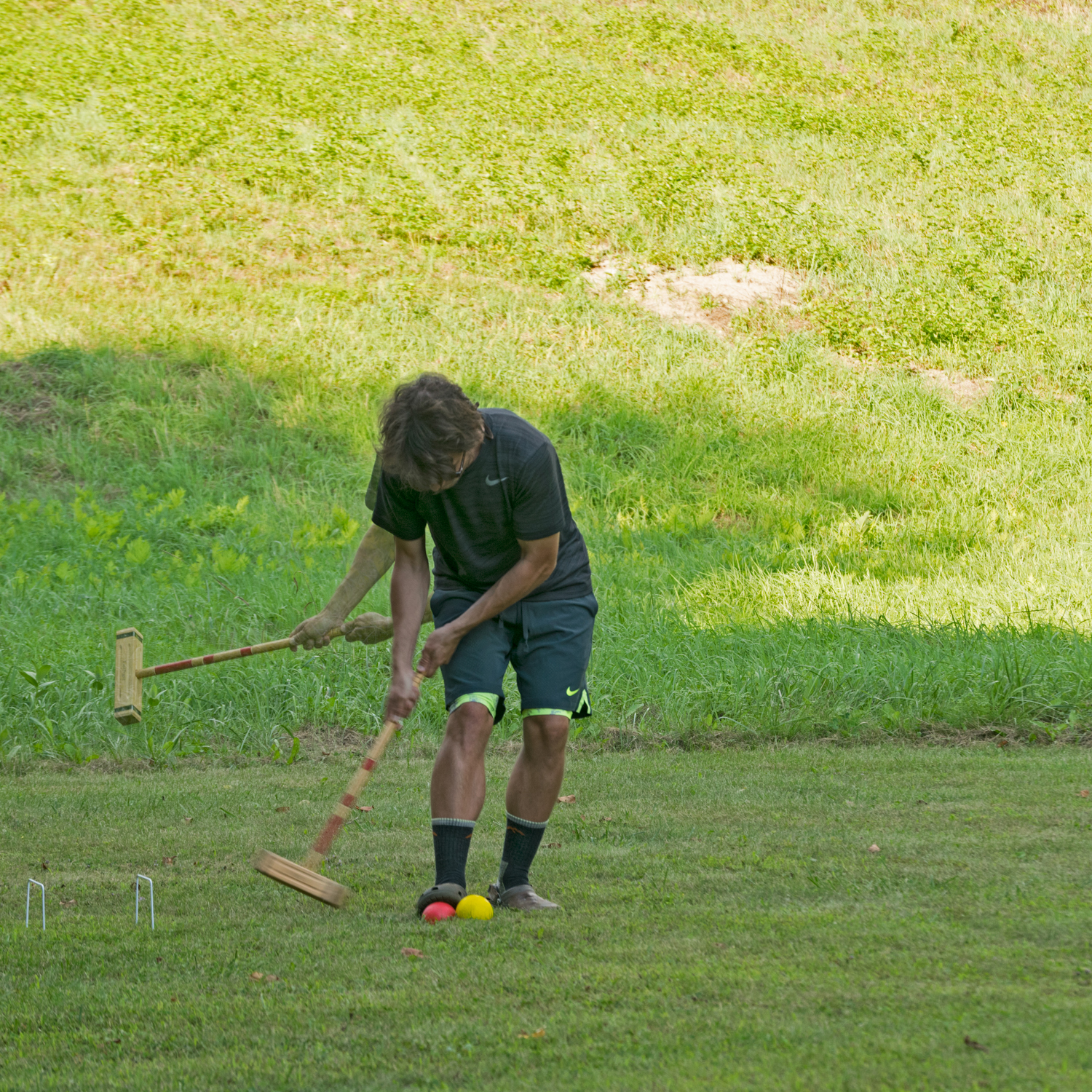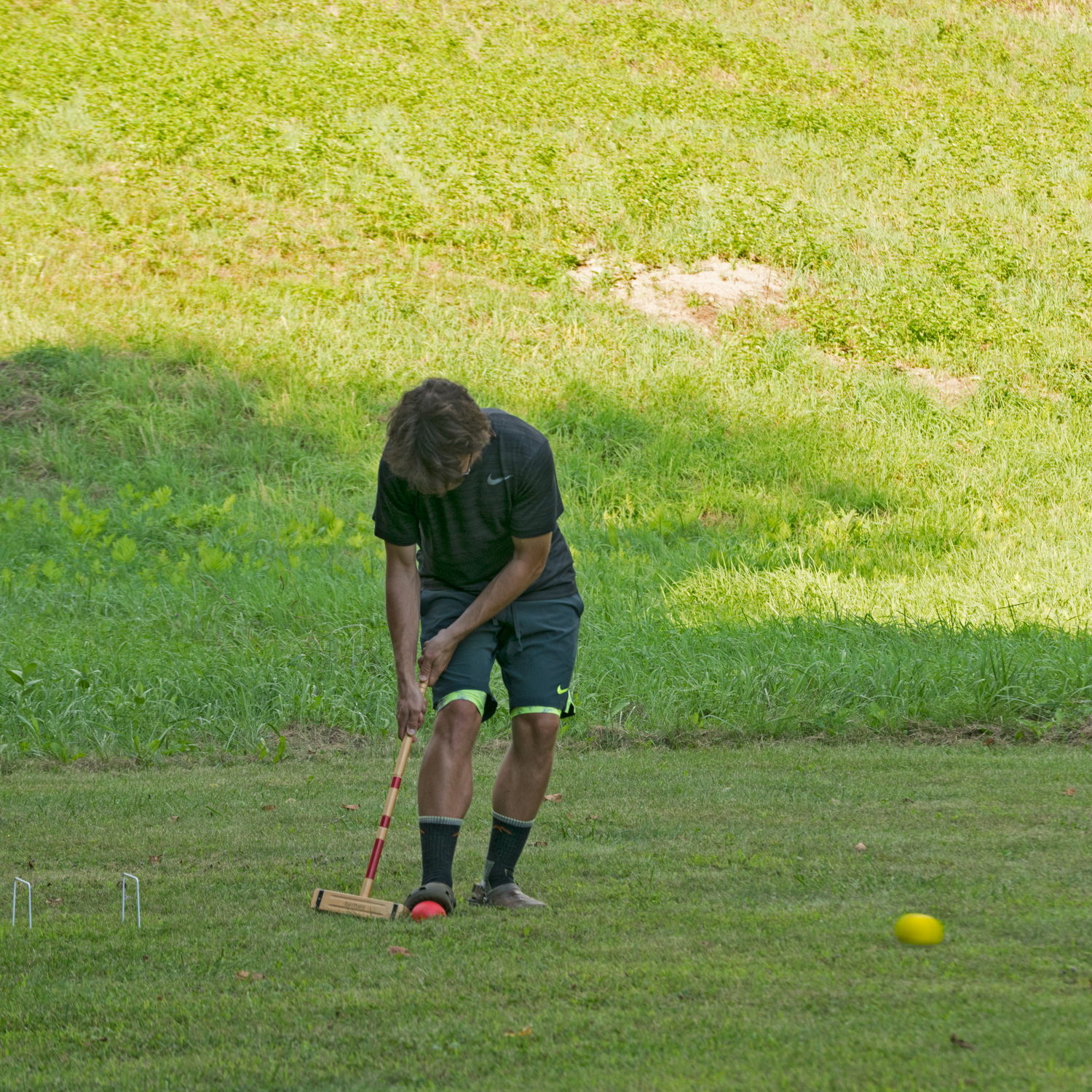Momentum
Momentum is a word that is probably not new to you. But what is it exactly? Momentum is something that depends equally on mass and velocity. Because velocity has a direction associated with it, so does momentum. In other words, momentum is a vector. It has some very special properties, as we will soon see.
The best way to understand momentum is to begin with some examples. First, consider a car and a truck traveling side-by-side on a highway.
A truck has more momentum than a car when they travel at the same speed because the truck has more mass.
The truck has more mass than the car. If they travel with the same velocity, the truck has more momentum than the car. Momentum is usually represented using the letter "p". Thus we can say that the momentum of the truck, p1, is more than the momentum of the car, p2. The direction of the momentum vector is the same as the direction of the velocity vector.
Next consider a car that is free to drive along a road. Assuming there are no road hazards or traffic, the car can travel at the speed limit, which might be 30 mph. The car's momentum depends on its mass and its velocity and is labeled p1 in the image below.
If there is no traffic and the roads are clear, a car can travel at the speed limit. Its momentum, which is called p1, points in the same direction as its velocity.
Now suppose the same car travels on the same road when there is a lot of traffic. It can't move as fast. Maybe it can only travel at 10 mph now. Its momentum, labeled p2 in the image below, is one-third of what it was at 30 mph. The change in momentum is due to the change in the car's velocity only, since the mass of the car is the same whether it is going fast or slow.
When a car moves slowly, its momentum is less than when it moves quickly. The momentum always points in the direction of the velocity.
Have you ever gone skiing? If so, you know that going up the hill is usually a lot slower than coming down the hill.
When you go uphill, your speed is less than when you ski down. Your mass is the same, though, no matter which way you travel. Because of the speed difference, you have less momentum going uphill than going downhill. The direction is different, too. Your momentum points uphill when you are riding the lift and it points downhill when you are skiing down. Even though the direction of the two momentum vectors is different, we can still compare their sizes. The size of the downhill momentum vector, p-down, is bigger than the size of the uphill one, p-up, and it is all because of the difference in the two speeds.
Conservation of Momentum
When one rolling ball strikes another, their combined momentum afterward is the same as it was before.
At first glance, momentum doesn't seem very special. After all, it is just a combination of mass and velocity and we know how they work. But there is something very unusual about momentum that is unlike either mass or velocity. Suppose you have one ball rolling toward another ball on a pool table. The balls collide and then travel off in different directions. If you add up the momentum of the balls before they hit and then add up the momentum of the balls afterward, the two sums will be exactly the same! In other words, the total momentum before the collision stays the same through the collision and then afterward. The formal way to say this is that the total momentum is conserved, which simply means that it doesn't change. Conservation of momentum is a guiding principle for predicting the motion of one or more objects. Because momentum is a vector, the conservation of momentum can take the collision of two balls coming together at an angle and predict the angles (or directions) - and speeds - of their motion afterward. And it works even for three or more balls - or objects of any kind - that interact with one another in some way.
One way to observe conservation of momentum is to create a collision between two toy cars of approximately equal mass.
Two cars of equal mass can be used to demonstrate conservation of momentum. A track or a slender piece of wood between the wheels helps keep the cars going straight.
The idea is to have one car (the black one, for example) sitting still and the other car (the brown one) rolling toward it. After they collide, the black car starts to move and the brown car either sits still or moves very slowly forward or backward. The motion of the brown car after the collision depends on the masses of the two cars. They could be equal or slightly different. It also depends on whether the collision is head-on or at a small angle. If you don't have a straight track for the cars to roll on, a slender piece of wood that fits between the wheels helps to keep the cars going straight.
In the series of images below, the brown car approaches the stationary black car at times t1 and t2. At time t3, the cars collide. At times t4, t5 and t6, the brown car doesn't move but the black car moves with about the same velocity as the brown car before the collision. The momentum of the brown car is transferred to the black car. The black car has a momentum of zero before the collision and the brown car has a momentum of zero afterward. Thus if you add up the momentum of the two cars, their total momentum is the same before and after the collision. In other words, the total momentum of the system - the two cars - is conserved.






Conservation of momentum is also common when you play croquet. One ball hits another. The first one stops and the second one moves. But momentum transfer can happen even if one of the balls doesn't move! Consider the case where you put your foot on one ball (the red ball in the pictures below) and then hit it with the mallet. If the red ball is touching another ball (the yellow ball in the pictures below), the momentum will transfer from the mallet, through the red ball, to the yellow ball. The yellow ball will move as if it had been hit by the mallet. This is pretty amazing when you think about it!
The momentum that is conserved in this example comes from the moving mallet. Earlier we said that the momentum of an object - a car or truck, for example - depends on mass and velocity in equal amounts. But when you are swinging a mallet, it is a bit tricky to think about it this way. The head of the mallet has a higher mass and velocity than the handle, but the handle may contribute some momentum when the mallet is swung. How much, though? Luckily, there is another way to figure out how much momentum the mallet delivers to the ball. We can use Newton's Second Law. This important law that relates a change in velocity to force and mass can be stated in a different way that relates a change in momentum to force and time.
If you apply a force to an object for some period of time, the momentum of the object will change. The change depends on the size of the force and the length of time that the force is applied.
Sometimes, as in the case of the croquet mallet, it is easier to measure the force and time during which it is exerted than to figure out how much of the mallet's mass contributes to the momentum when it is swung. If a croquet ball has no momentum initially, its new momentum can be determined if we know the force applied by the mallet and the time of contact between the mallet and the ball.
So far, we have only seen examples where the momentum before and after an event are in the same direction. This isn't always the case. Conservation of momentum also tells us what happens when objects move at an angle to one another. This is usually true when marbles or pool balls collide with one another. Suppose you have two marbles. Let one of them sit still on any flat surface, like a kitchen counter top, table, or floor. Roll the other one so that it hits the first one. Don't make the collision head-on but rather, try to make the side of the rolling marble strike the side of the stationary marble. This is sometimes called a glancing collision. You may have to practice a few times to make it work!
The green marble rolls into the black one. After hitting the black one, both marbles move off in different directions.
Here the green marble starts in the lower right and rolls into the black marble, which is sitting still. The green marble strikes the black marble, and the collision is shown inside the blue circle. After the collision, the positions of the two marbles are shown at three times: time 1, time 2, and time 3. The black marble starts to move in a direction marked by the yellow arrow and the green marble starts to move in a new direction, shown by the red arrow. Depending on the mass of the marbles and whether they have a head-on collision or not, the velocities of the marbles will be different after the collision. They will be different from one another and most likely different from what is shown here.
What happens with the momentum? To understand the momentum before and after, it is helpful to draw three lines on the diagram. One line, called Line 0 in the image below, shows the line of travel of the green marble before the collision. Another, Line 1, shows the line of travel of the green marble after the collision. A third, Line 2, shows the line of travel of the black marble after the collision.
Three lines are used to mark the movement of one marble before the collision (Line 0) and both marbles after the collision (Line 1 and Line 2).
The next step is to label the momentum of the marbles before and after the collision. The directions of the momentum vectors are the same as those for the velocities before and after the collision, so the momentum vectors will lie along the three lines. Let p0, in pink, be the momentum of the green marble before the collision. Let p1, in red, be the momentum of the green marble after the collision. And let p2, in green, be the momentum of the black marble after the collision.
Vectors show the momentum before (p0) and after (p1 and p2) the collision.
The lengths of the momentum vectors depend on the masses of the marbles as well as their velocities. The green marble moves faster before the collision than afterward, and that's why its momentum before, p0, is larger in size than it is after, p1. If you compare the distances traveled by each marble after the collision, it looks like the green marble moves faster in each time interval than the black marble. However, the black marble has more mass than the green marble. Its momentum is therefore almost the same size as the green marble's momentum.
How can we tell if the total momentum before the collision is the same as that after the collision? We can use vector addition! It is easy if we pick up the vectors and move them to a blank space, making sure that we don't change their lengths or directions. In the image below, the momentum vectors p1 and p2 are moved to the right. The tail of p2 (green) is positioned at the head of p1 (red). The vector sum, p1 + p2 (purple), is drawn from the tail of p1 to the head of p2. It represents the total momentum after the collision.
Vector addition is used to show that the total momentum after the collision is the same as the total momentum before the collision.
Because only the green marble is moving before the collision, p0 represents the total momentum before the collision. Thus we need to compare p0 with p1 + p2 to see if momentum is conserved. Both vectors are copied to a new location, slightly above the vector sum. The diagram shows that p1 + p2 is exactly the same as p0. Both vectors have the same length and point in the same direction. This confirms that momentum is conserved!
Conservation of momentum happens when a cannon recoils after it is fired and when a rocket lifts off the ground as the exhaust from its burning fuel is ejected downward. In the case of the rocket, something else happens as well. The rocket exhaust has a very high velocity and its momentum at any time is equal and opposite that of the rocket and whatever unburned fuel is still on board. But as that fuel is burned, the rocket and remaining fuel together get lighter. Because momentum depends equally on mass and velocity, the reduction in fuel inside the rocket causes the velocity of the rocket and unburned fuel to continually increase as their combined mass decreases. In other words, rockets go faster when they are burning fuel!












